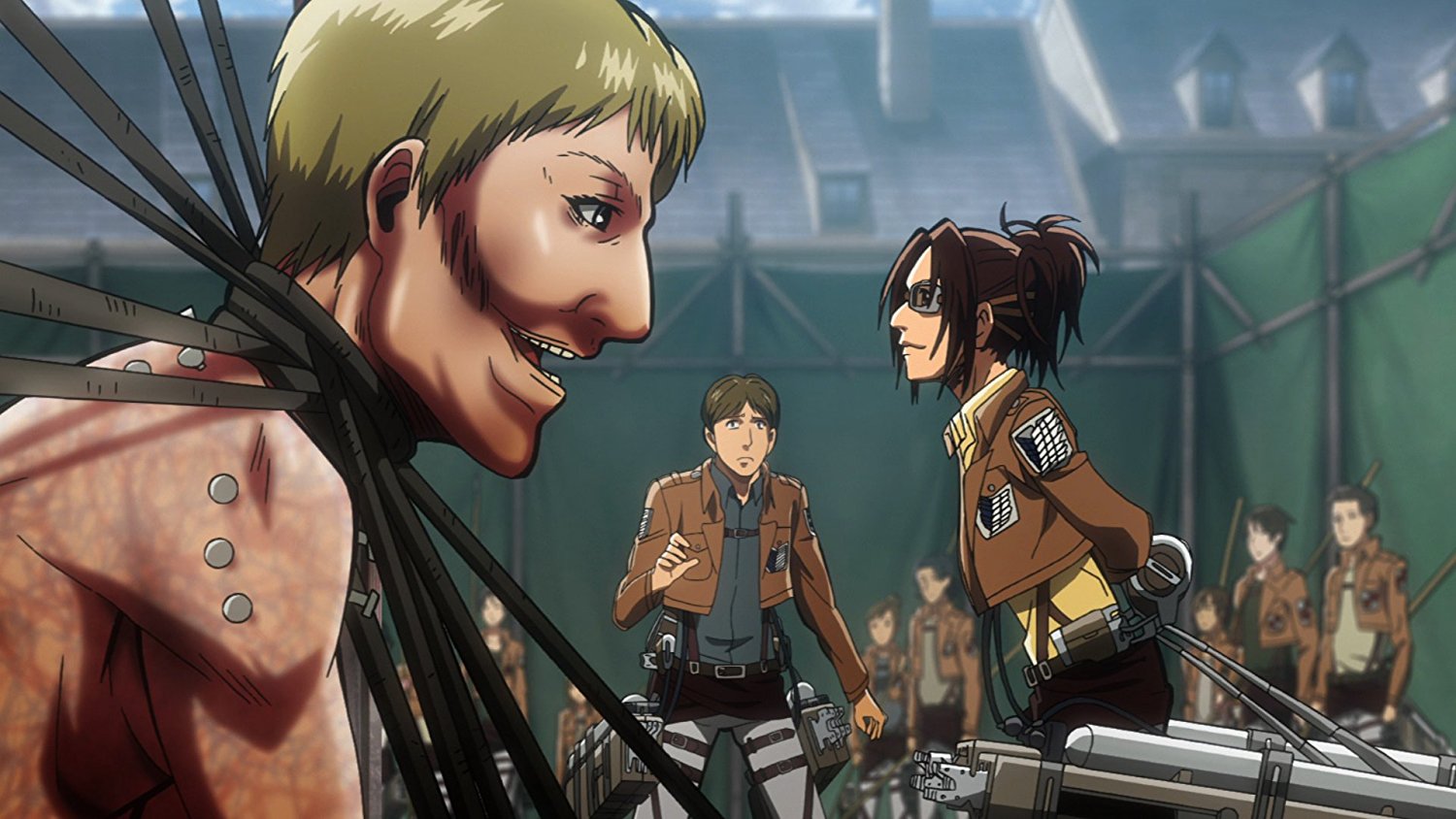Attack On Titan Makes Giant Monsters Scary Again
Hit anime series Attack On Titan, now on its second season, contains some truly scary giant monsters...
In 1954, when the mighty Godzilla first strode across Tokyo, he cut a terrifying figure: nothing less than the scaly, city-levelling embodiment of war, the giant monster was far from the figure of fun he would later become. A horrifying, even tragic air hangs over Ishiro Honda’s seminal kaiju movie, which inspired a wave of similar giant-monster epics, from a long-running series of Godzilla sequels to Mothra, Rodan, and Gamera to affectionate tributes like Guillermo del Toro’s Pacific Rim.
It’s arguable, though, that most kaiju movies mislaid the sense of terror that rang out so clearly in the original Godzilla. Like so many film monsters, Godzilla soon morphed from the embodiment of war to a loveable mascot – a character whose spiky form appeared in toy form and on the cover of videogames, comics and other merchandise.
First a manga by Hajime Isamaya, now a hit anime series and multimedia franchise, Attack On Titan doesn’t fall in the kaiju genre as such, but its giant monsters are, for this writer, the scariest to emerge from Japan in decades. Like Godzilla, the series’ Titans are like something from a nightmare: familiar yet twisted looking; faintly comical, yet capable of causing extraordinary horror and devastation.
The premise behind Attack On Titan is as sprawling as the monsters are tall. A century ago, the Earth was decimated by the sudden appearance of the Titans: colossal, profoundly naked humanoid creatures that seem to exist solely to eat every regular-sized person they see. In the present, humanity’s survivors live in cities surrounded by concentric rings of giant walls – all the better to keep the monsters at bay. For decades, the defensive measure remained in place – keeping the Titans out, but also limiting several generations of kids to a confined existence.
The arrival of a Colossus Titan, larger than any seen before, suddenly changes everything. An outer wall once thought impregnable is breached, and the once settled human population is sent into retreat; with the Titans again on the march, a specialist military outfit is formed to protect the cities from destruction.
With a bewilderingly large cast, Attack On Titan‘s animated series contains much that is familiar from other Japanese TV shows, including a cast of young heroes with changing and increasingly fraught relationships. There’s hero Eren Yeager, a cadet haunted by the death of his mother; Mikasa, Eren’s close friend and an adept fighter; the delicate Armin, whose intelligence far outweighs his strength and combat ability. But while the character dynamics are fairly stock, the world-building is superb – and while the cobbled streets and European-looking medieval cities hint at fantasy, Attack On Titan really has more in common with Robert Heinlein’s Starship Troopers.
To fight the Titans, the military adopts some coolly-realised battle technology, which includes razor-sharp swords and a kind of gas-powered cable system that allows the wearer to zip from building to building like a mechanical Spider-Man. This comes in particularly handy, not only for evading the Titans’ hands and gnashing teeth, but also for landing a killer blow: the giants are largely invulnerable to injury other than a small spot on the back of their necks. Only with a carefully-timed blow can a Titan be put out of action.
The Titans, then, are a true force to be reckoned with: almost zombie-like in their speed and gait, but ferociously strong and constantly hungry. Isamaya brings a certain surrealism to his monsters, too: with their staring eyes, lack of clothes and taste for human flesh, they recall some of the most unnerving scenes in George A. Romero’s Night Of The Living Dead. More eerie still are the little revelations that Isamaya dishes out every few episodes: take, for example, the part where it emerges that Titans occasionally puke back up the mangled remains of their victims, like some kind of giant owl pellet.
There are other twists, too, that constantly change our perceptions of what the Titans are and what they want – we’ll leave you to discover those for yourselves, assuming you haven’t already.

Exactly what the Titans represent has made the series and its creator the subject of some controversy, particularly in the far east. Some have commentators have argued that it’s a right-wing call to arms, coinciding with a more hawkish Japanese government led by its premiere, Shinzo Abe. When reports emerged that a character in the series, Dot Pixis, was based on an infamous general in the Japanese imperial army, Isamaya received hundreds of anonymous death threats.
Whatever Isamaya’s intent behind Attack On Titan, there’s no denying the strength of the imagery he created in his manga. In Japan and surrounding countries, it’s little short of a phenomenon, inspiring videogames, merchandise, and a two-part live-action film, released in 2015. The anime series, with its second season out now on Blu-ray, offers a constant rollercoaster of teamwork, bravery, and shock deaths – indeed, one of the things that defines Attack On Titan is how suddenly and brutally characters can suddenly be killed off.
Above all, though, Attack On Titan thrives on the horrifying presence of its title monsters. Sometimes, they’re so weird looking, they almost look absurd – check out the stumpy one with the giant head at the start of season two – but then, their outlandish also adds to their nightmarish mystique. The series itself isn’t necessarily perfect – it’s often too heavy on dialogue and talking heads, while its melodrama is sometimes a little too over-the-top – but the Titans themselves have remained legitimately scary in the episodes we’ve seen to date. Like Godzilla before them, these monsters are a real force of nature.